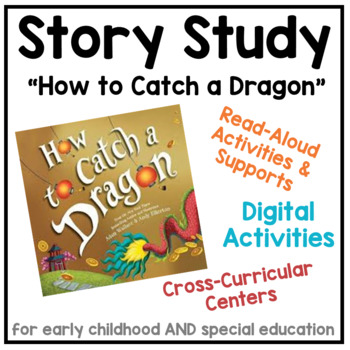Story Study - "How to Catch a Dragon" - Thematic Unit for ECE & Special Ed
- Zip
What educators are saying
Description
Just in time for Chinese New Year, this adorable story is a hit with the kids!
"But how will I incorporate it into my lesson plans?"
Enter 'Story Studies', thematic units of study for our favorite books!
This product is specially designed with interactive elements and engaging visual supports that are perfect for little learners and learners with special needs!
With elements that support you and your students throughout the school day, in various subject areas, and lasting a week or more, your kiddos will be sure to get the most out of this adorable story while learning new skills or reviewing known concepts!
What's Included?
Read-Aloud Printables
- Story Board visuals to identify story elements
- labels for parts of a book
- compare and contrast anchor charts
- beginning, middle, end anchor charts
- sequencing anchor charts
- science senses story elements sort anchor charts
- WH- Q sort anchor chart
- Yes/No True/False sort anchor chart
- differentiated vocabulary puzzles
- predictable/shared writing/tracing prompts with visuals
- visuals for build-a-scene activity to use during or after read-alouds
- character, setting, event sort anchor charts
- read-aloud questions: cards and sticky note printables
- fringe board for AAC and core vocabulary users, as well as visual cue cards for high-frequency words from my Core Vocabulary Communication board (included!)
- "magic wands" to use as pointers during reading or instruction
- Comprehension Assessment with circle/gesture and cut/glue options
Cross-Curricular Centers
- Pretend Play resources including:
- headbands with character names and pictures
- wristbands with character names and pictures
- nametags with character names and pictures
- labels and decorations for pretend play items and areas
- story element color sort
- story element big and small
- story element counting
- story element 1:1 correspondence
- story element number comparing
- story element shapes
- story element scientific investigations: labeling element names and traits
- story element parts of speech
- story elements beginning sounds
Digital Interactivities
- Comprehension questions with small visual arrays
- Build-a-Scene interactive template to act out scenes or follow prompts
- Cloze-maze activity with word bank
- Main Idea and Key Details
- Beginning, Middle, End
- Sequencing
- Vocabulary puzzles
- Compare and Contrast
- Story Element big and small
- Story Element colors
- Story Element counting
- Story Element sizes
- Story Element scientific investigation: label items and identify traits
- Story Element parts of speech
- Story Elements beginning sounds
Year-Round "How to Catch..." COMING SOON - follow me here on TPT and on Instagram @justaddvisuals


